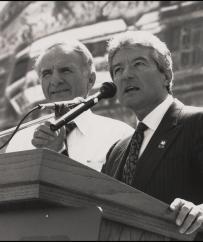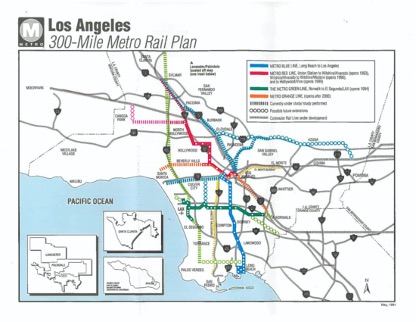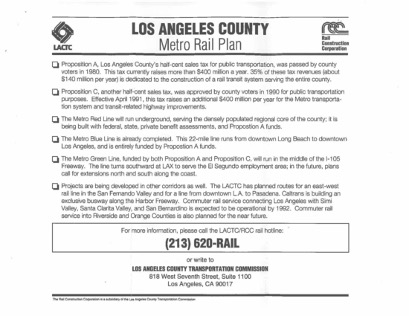To provide a different perspective on the issue of planning for Metro Rail, The Planning Report spoke with Nick Patsaouras, President of the Southern California Rapid Transit District (SCRTD) and an alternate member of the LACTC Board.

Nick Patsaouras on right
Patsaouras: "We have a system that's not going to work and unless we have major surgery, it's going to be a disaster."
What is your view of the planning effort to capture the public investment on Metro Rail?
I discovered that the design of Metro Rail was done strictly by the engineers and with a total lack of communication among the CRA, Planning Department, LADOT, RCC, and RTD. I was shocked when these agencies admitted to me that they have not ever talked. We have a multibillion dollar system in which the agencies involved have never communicated. And the agencies have conflicting objectives: the CRA is interested in getting developers around the stations, the RCC in reducing costs, the RID in bringing in buses, and so on. We have a system that’s not going to work and unless we have major surgery, it’s going to be a disaster.
What radical surgery do you believe is necessary?
It will take tough decisions by the City, by LACTC, and the CRA. For example, we need to redesign the stations. At Hollywood and Highland we have a station which originally had two portals, but the portal at the northeast corner has been eliminated, creating a safety hazard for the patrons who will have to cross Highland to enter. Another travesty is the Wilshire/Vermont station where the portal is at the center of the northwest block, obscured by high-rise buildings at the southwest corner of that block.
What do you say to those who argue that we can take a second look at these planning issues in the future?
Since you’re spending millions for design and construction, you either do it or you don’t — you can’t say you’ll come back since there will be only one station at each site. At Hollywood and Western there's a hamburger stand, an adult book store, and a motel. You need to take whole blocks and master plan them, with facilities for buses, park and ride, kiss and ride, and clean up the area. The Commission could use eminent domain to take control of that boarded up area and use joint development. Once developers see a plan for that intersection, they’ll move in.
But what do you say to the argument that the press and the public in recent years have only been interested in the cost issues on Metro Rail and uninterested in planning issues?
That’s the failure of the leadership to present to the public in a coherent way the benefits of a plan — $2 million saved by eliminating a portal or $100,000 for a master plan are crumbs compared to the future of this city. We have eliminated all of the mezzanines so that the ticket machines are at surface level. At Wilshire/Vermont, picture the 35,000 passengers per day projected queuing up for tickets — that’s a failure of the system before we’ve even started.
Why should the development community care about these issues?
These public/private partnerships are the only opportunities for developers over the next ten years. Without LACTC becoming a partner in providing land and providing credits for parking, major projects in L.A. are history. I know joint development can work because RTD in May will have a final agreement with Catellus for our headquarters.
On April 15, 1991 Melanie Fallon said the city would like to spend $1 million for specific plans around the stations, but that the effort has been hampered by the city’s budget crunch. On April 15, 1992 we will be testing the transportation system…
There’s always resistance from the RCC whose engineers only look at cost without vision for the city a hundred years from now.
- Log in to post comments





